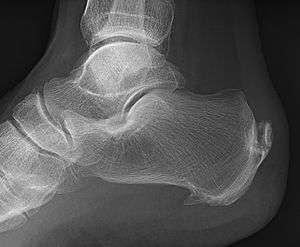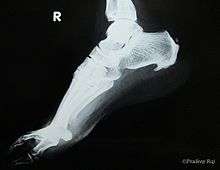Calcaneal spur
A calcaneal spur is a bony outgrowth from the calcaneal tuberosity (heel bone).[1] Calcaneal spurs are typically detected by x-ray examination.[2] It is a form of exostosis.
| Calcaneal spur | |
|---|---|
| Other names | Heel spur |
 | |
| A radiograph showing osteophytes on the posterior and inferior aspects of the calcaneus | |
| Specialty | Rheumatology |
When a foot is exposed to constant stress, calcium deposits build up on the bottom of the heel bone. Generally, this has no effect on a person's daily life. However, repeated damage can cause these deposits to pile up on each other, causing a spur-shaped deformity, called a calcaneal (or heel) spur.[3]
An inferior calcaneal spur is located on the inferior aspect of the calcaneus and is typically a response to plantar fasciitis over a period, but may also be associated with ankylosing spondylitis (typically in children). A posterior calcaneal spur develops on the back of the heel at the insertion of the Achilles tendon.[3]
An inferior calcaneal spur consists of a calcification of the calcaneus, which lies superior to the plantar fascia at the insertion of the plantar fascia. A posterior calcaneal spur is often large and palpable through the skin and may need to be removed as part of the treatment of insertional Achilles tendonitis.[3]
Signs and symptoms

Major symptoms consist of pain in the region surrounding the spur, which typically increases in intensity after prolonged periods of rest. Patients may report heel pain to be more severe when waking up in the morning. Patients may not be able to bear weight on the afflicted heel comfortably. Running, walking, or lifting heavy weight may exacerbate the issue.[4]
Causes
Plantar fasciitis is a common cause of calcaneal spurs. When stress is put on the plantar fascia ligament, it does not cause only plantar fasciitis, but causes a heel spur where the plantar fascia attaches to the heel bone.[5] Generally, a calcaneal spur develops when proper care is not given to the foot and heels.[2] People who are obese, have flat feet, or who often wear high-heeled shoes are most susceptible to heel spurs.[5]
Diagnosis
Spur outgrowths can be detected through physical exam followed by a lateral foot x-ray.
Treatment
It is often seen as a repetitive stress injury, and thus lifestyle modification is typically the basic course of management strategies. For example, a person should begin doing foot and calf workouts. Strong muscles in the calves and lower legs will help take the stress off the bone and prevent heel spurs. Icing the area is an effective way to get immediate pain relief.[6]
References
- Kirkpatrick et al. 2017. The plantar calcaneal spur: a review of anatomy, histology, etiology and key associations. Journal of Anatomy: http://onlinelibrary.wiley.com/doi/10.1111/joa.12607/full
- "Heel and Foot Pain". Patient.info. July 24, 2017. Retrieved December 9, 2017.
- CE4RT.com (November 18, 2013). Radiography of the Foot. p. 19. Retrieved December 9, 2017.
- "Plantar Fasciitis and Heel Spurs". Spoc-Ortho.com. Archived from the original on December 10, 2017. Retrieved December 9, 2017.
- E.K. Agyekum (June 2015). "Heel pain: A systematic review". Chinese Journal of Traumatology. 18 (3): 164–169. doi:10.1016/j.cjtee.2015.03.002. PMID 26643244.
- "4 Ways to Get Rid of Heel Spurs". wikiHow. 2007-05-04. Retrieved 2016-12-20.